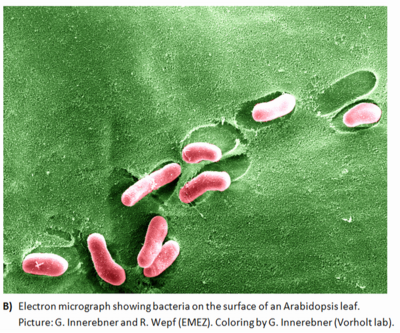Microbial corrosion: Difference between revisions
Cronie etc (talk | contribs) No edit summary |
Cronie etc (talk | contribs) No edit summary |
||
| Line 17: | Line 17: | ||
their [http://en.wikipedia.org/wiki/Cellular_respiration respiration] techniques. | their [http://en.wikipedia.org/wiki/Cellular_respiration respiration] techniques. | ||
Some common examples of these are: | Some common examples of these are: | ||
Sulfate-reducing bacteria (SRB), including Desulfuromonas sp., Desulfobacter sp., and Desulfococcus sp., etc. The SRB are strictly anaerobic.² | ===-Sulfate-reducing bacteria (SRB)===, including Desulfuromonas sp., Desulfobacter sp., and Desulfococcus sp., etc. The SRB are strictly anaerobic.² | ||
Sulfur-oxidizing bacteria, primarily of the genus Thiobacillus. These organisms notably form sulfuric acid during oxidation, and are capable of both oxidizing sulfur and ferrous iron.² | Sulfur-oxidizing bacteria, primarily of the genus Thiobacillus. These organisms notably form sulfuric acid during oxidation, and are capable of both oxidizing sulfur and ferrous iron.² | ||
“Iron” bacteria, of which there are two types: ‘stalked’ (notably Gallionella sp.) and ‘filamentous’ (Leptothrix sp, Clonothrix sp, Sphaerotilus sp, etc.). These bacteria primarily oxidize or reduce iron species during respiration.² | “Iron” bacteria, of which there are two types: ‘stalked’ (notably Gallionella sp.) and ‘filamentous’ (Leptothrix sp, Clonothrix sp, Sphaerotilus sp, etc.). These bacteria primarily oxidize or reduce iron species during respiration.² | ||
Revision as of 06:52, 1 December 2012
Introduction
The [phyllosphere] refers to the above-ground surfaces of a plant as a habitat for microorganisms, with a heavy emphasis on leaf surfaces. All plants are home to a wide variety of microorganism communities including bacteria, fungi, and yeasts. Some microorganisms benefit the plant, others are plant pathogens and can potentially damage or kill the host plant (4). The majority of bacterial colonists on any given plant have no noticeable effect on plant growth or function.
Estimates suggest that the roughly 1 billion square kilometers of worldwide leaf surfaces host more than 10^26 bacteria, which are the most abundant colonizers of this habitat. Overall, microbiota in this ecosystem are large enough to have an impact on both global carbon and nitrogen cycles. Further more the phyllosphere mircroorganisms influence their hosts at the level of the individual plants.
With repeated and rapid constant change of environmental conditions occurring on leaf surfaces, the phyllosphere is recognized as a hostile environment to bacteria. Leaf surfaces are often dry and temperatures can reach 40–55°C under intense sunlight. During the night, however, leaves are frequently wet with dew and at cool temperatures (5–10°C) (2).
Microbes that live in the Phyllosphere are called [Epiphytes]
Associated taxa
Many different bacterial genera are associated with MIC and are often categorized by their respiration techniques. Some common examples of these are: ===-Sulfate-reducing bacteria (SRB)===, including Desulfuromonas sp., Desulfobacter sp., and Desulfococcus sp., etc. The SRB are strictly anaerobic.² Sulfur-oxidizing bacteria, primarily of the genus Thiobacillus. These organisms notably form sulfuric acid during oxidation, and are capable of both oxidizing sulfur and ferrous iron.² “Iron” bacteria, of which there are two types: ‘stalked’ (notably Gallionella sp.) and ‘filamentous’ (Leptothrix sp, Clonothrix sp, Sphaerotilus sp, etc.). These bacteria primarily oxidize or reduce iron species during respiration.² There are many other miscellaneous groups of bacteria that use or respire metallic substances and contribute to biocorrosion. Some Pseudomonas species can reduce iron, while other bacterial species can oxidize/reduce less abundant metals like manganese, palladium, nickel, etc. There are also biocorrosive bacteria that do not utilize metals but secrete organic acids which can break down surrounding materials.¹ ² It is important to note that not all species within a genus induce MIC and not all perform the same types of respiration.
Mechanisms of action
Microbial uses
Effects on materials
References
(1) Lindow, S. Brandl, M. 2003. "Microbiology of the Phyllosphere." Applied and Environmental Microbiology. Vol. 69, No.4. 0099-2240
(2) Delmonte, N., Knief, C., Chaffron, S., 2009. "Community proteogenomics reveals insights into the physiology of phyllosphere." National Academy of Sciences.
(3) Machowicz-Stefaniak, Z., Krol, E. 2006. "Biotic effect of caraway phyllosphere fungi on the pathogenic fungus." Department of Plant Pathology University of Life Science. 2-8
(4)Suslow, T. 2005. "Microbial Food Safety IS Your Responsibility." Vegetable Research Information Center. 1-6.
(5) Howplantswork. 2009. "Life in the Phyllosphere: What Microbes Commonly Dwell on the Surface of Leaves?."
(6) Whipps, J.M. Hand, P. Pink, D. 2008. "Phyllosphere microbiology with special reference to diversity and plant genotype." 2-34
(7) Gardener, B., Frafel, D. 2002. "Biological Control of Plant Pathogens: Research, Commercialization, and Application in the USA." Plant Health Progress. 1-18
(8) Abell, G., Richter, A. 2008. "Nitrogen fixation by phyllosphere bacteria associated with higher plants and their colonizing epiphytes of a tropical lowland rainforest of Costa Rica." The IMSE journal. 2, 561–570
Edited by student of Angela Kent at the University of Illinois at Urbana-Champaign.

